I’ve had a lifelong love affair with chile verde, which is probably the only dish in existence that could ever inspire me to write a sentence this corny. Ah, love — the corniest emotion.
As I mentioned in my article about the taco truck mecca that is my home region in the Central San Joaquin Valley, chile verde (virtually always spelled chile verde here, not chili verde, though it is sort of a chili) is one of those dishes that became almost impossible to find, at least in the form I knew it, as soon as I left home. I lived in San Diego in the early aughts for college and while it has plenty of amazing Mexican food, possibly more than any place in the country, it didn’t, as far as I could find, have anything I would recognize as chile verde
Good luck finding the definitive history of chile verde, or even a definitive spelling. Some say it originated in Northern Mexico, others mention New Mexico and Colorado. One day we’ll have to work all that out, but for now, suffice it to say, the chile verde I fell in love with came from a little Mexican joint called Juanito’s in Reedley, California, and its one-time sister restaurant, Lalo’s, in nearby Dinuba — both in the rural San Joaquin Valley. “Chile verde” can refer to this entire dish, which is basically a pork stew, or to the actual green vegetables used in it, like Anaheim, poblano, serrano, jalapeño. The version I fell for had tender pork, tomatillos, and… well shit, what else did it have?
I only knew what I could taste and infer. I’ve basically been trying to reverse-engineer this chile verde for 20 years, and I talk about it so much that it’s probably my most requested recipe. I’m putting it down here for posterity. (And I don’t want to hear anyone bitching about how we recipe writers all have to write an essay before we get to the damn recipe — indulge me! I’m rhapsodizin’ ova heah!). Now that I actually know some of the people who run those restaurants I mentioned above, I’ve asked how they make theirs, and it’s actually way different than this.
I still stick with my version. Partly because I don’t have a restaurant kitchen in my house, but mostly because I’ve made this version, I’ve tested it, I love it, and it’s always been a success. I’m choosing Super Bowl week to share it with you because I think it’s a great dish for a party. Not a finger food, admittedly (though you could make it one), but a real crowd-pleaser. You can also make it a day or two ahead of time (it’s arguably better that way), and it feeds a lot of people relatively cheaply. It’s always been a hit at my house. And who are you to dispute me?
You insult me in my own house?
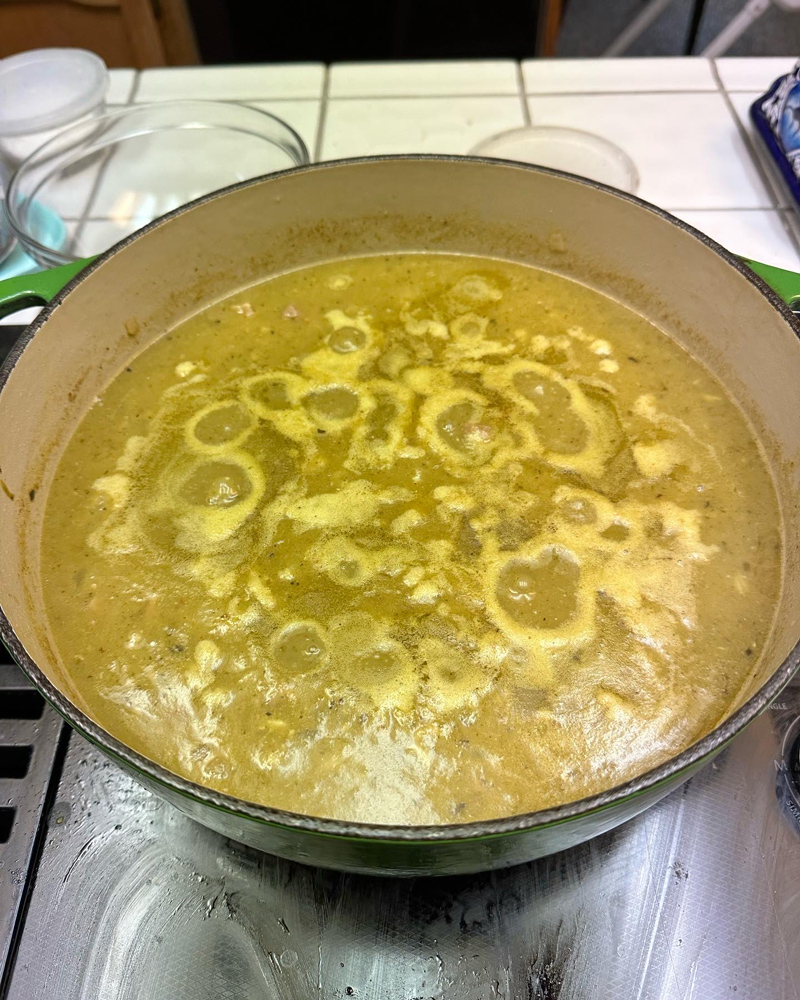
The Recipe
Chile verde essentially consists of three components:
– The Broth
– The Meat
– The Vegetables
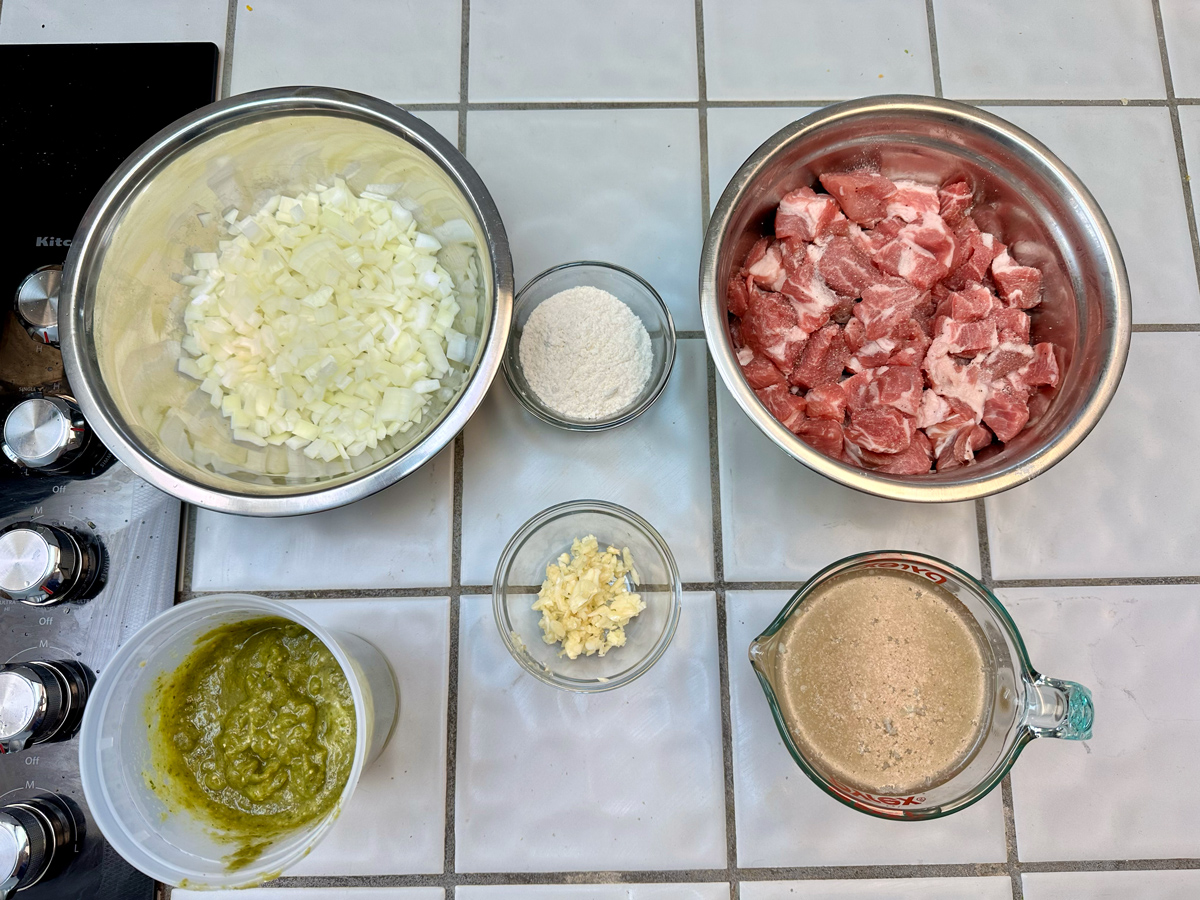
You’re largely going to prep these separately, so it’s easier to think of them as separate components that you’ll eventually put together for the stew. It makes the full list of ingredients look messy and complicated, which it really isn’t, but you’ll still need a shopping list, so here goes:
- 2-6 pounds pork shoulder/pork butt (boneless is slightly easier to butcher, but it doesn’t really matter)
- 1 head of garlic plus 4-5 cloves
- 5-6 tomatillos, roughly golf-ball sized.
- 4-5 Anaheim chiles (try to make sure they’re the mild kind)
- 1-2 poblano chiles
- 1 large onion
- 1 bunch cilantro
- Dried oregano
The Broth
You’re going to need enough stock to cover your meat, generally 2-3 cups worth. Now listen: making your own stock is kind of a pain in the ass. It will add a day to the process, and I’ll be the first to tell you that it’s not strictly necessary. If you want to use water and some chicken bullion powder, or broth from a can or a carton (chicken or beef, it honestly doesn’t matter that much) go for it. I’ve made chile verde that way many, many times and it’s still really good. By stewing the meat you’ll basically be making your own broth anyway. For a party, I do like to go all out and make my own. Because nothing makes a dish better than starting with an already-rich broth.
If you want to do that, it’s going to involve:
- A few pounds chicken backs or feet, pork neck bones, or beef soup bones
- 1 onion, quarterd
- 1-2 carrots, washed and cut into 2-3 inch chunks (no need to peel)
- 1-2 celery ribs, washed and cut into 2-3 inch chunks
https://www.instagram.com/p/CoIypI4rBRb/
I have an Asian supermarket near my house that’s great for finding soup bones, which my usual supermarket doesn’t have. You want anything that has lots of bones and cartilage — lots of people swear by chicken feet. This time I used some big-ass beef knuckle-looking things, but pork necks also work great.
Just get your stock pot nice and hot and pour a little oil in there (should be hot enough that the oil ripples). Then take your bony meat whatevers, and sear them in the hot stock pot. If it gets a little crusty and sticky on the bottom, that’s good. Once the meat/bones have a little brown to them, fill the pot up with water, stick it back on the stove, and add your vegetables, plus a healthy amount of salt and pepper (probably a palm’s worth of salt and a teaspoon-ish of pepper, but you can adjust at the end). Boil that for at least two hours, skimming the scummy stuff off the top as much as you want along the way.
Once it’s done boiling, strain all the solids out. If you’re steady with a ladle, you can try to scoop all the fat off the top. Hopefully, you have some time to refrigerate though, that way you can just break the congealed fat off the top after it’s cooled. That’s way easier.
The Vegetables
Here’s where things get controversial. As you would expect, a dish called “chile verde” obviously has some “verde” “chiles” in it. Beyond that, there’s quite a bit of variation. Not to mention a plethora of green chiles, specifically. I grew up on tomatillo-heavy chile verde, so I still make it with tomatillos — which are tart and tangy, enough that I don’t think it needs lime. I also don’t use anything really spicy in mine, like serranos or jalapeños, though I’m not against it. I just keep mine fairly mild so the kids can eat it and then pair it with a spicy pico de gallo so people can get as xXxtreme as they like in a Choose Your Own Spice Level-type situaish.
Personal preffy, ya know?
- 5-6 tomatillos, approximately golf ball-sized (take off the crinkly outer shell and wash the berry part)
- 4-5 Anaheim chiles
- 1-2 poblano peppers
- 1 head of garlic
- Half cup-ish of cilantro
- Dash of salt
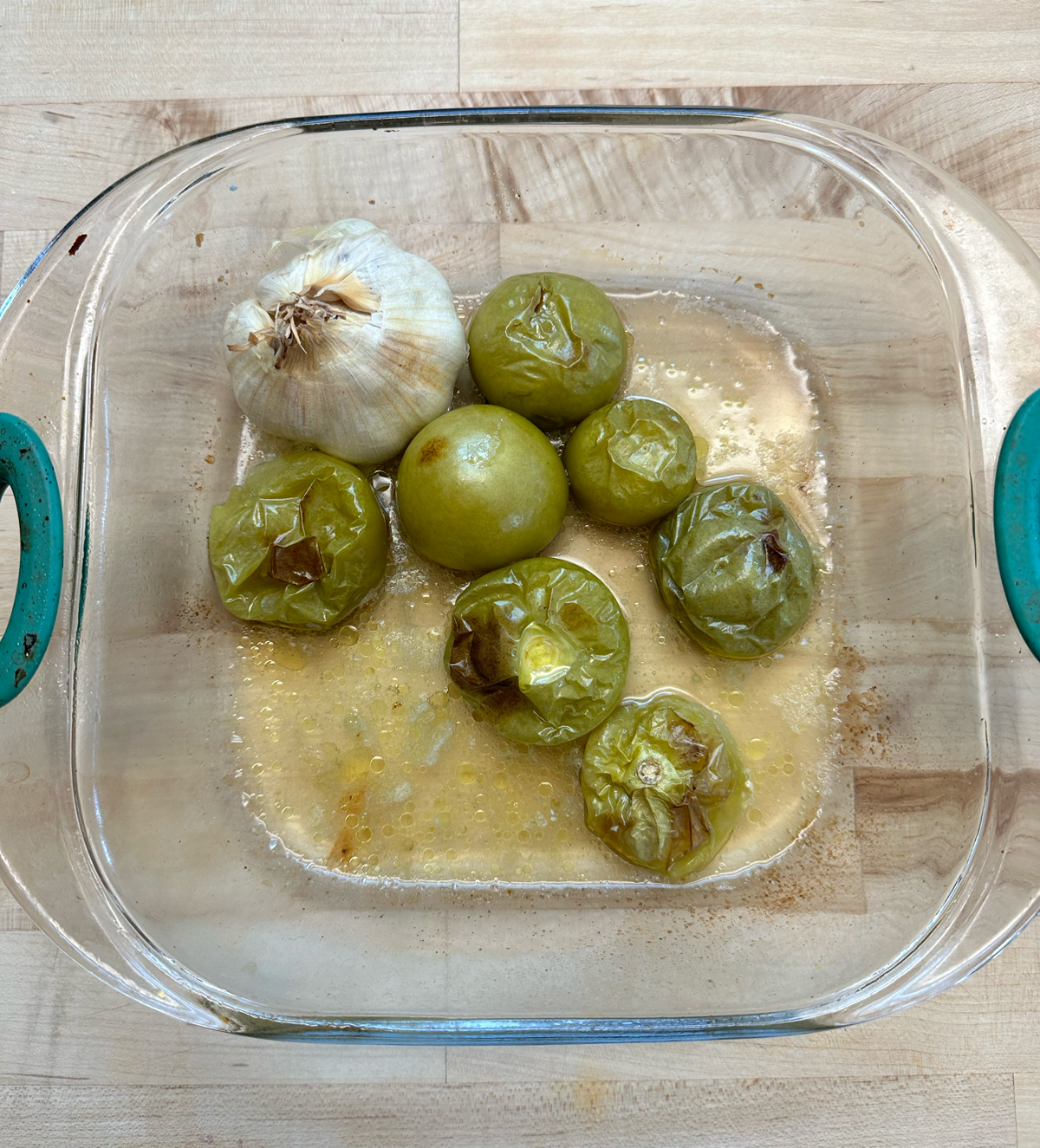
The easiest way:
Just throw your tomatillos, chiles, and garlic (keep the whole head intact with all the skin on for cooking) in a baking dish at about 450 and bake until the chiles char and the tomatillos split. Then let them cool, remove the skins and seeds from the chiles (should be easy with enough char), pop out the garlic cloves (again, should be easy, they sort of steam in there and get greenish and nutty), and toss everything in a blender with a little cilantro and a dash of salt and then puree. Use a rubber spatula to get all that awesome, partly charred tomatillo juice off the baking or casserole dish.
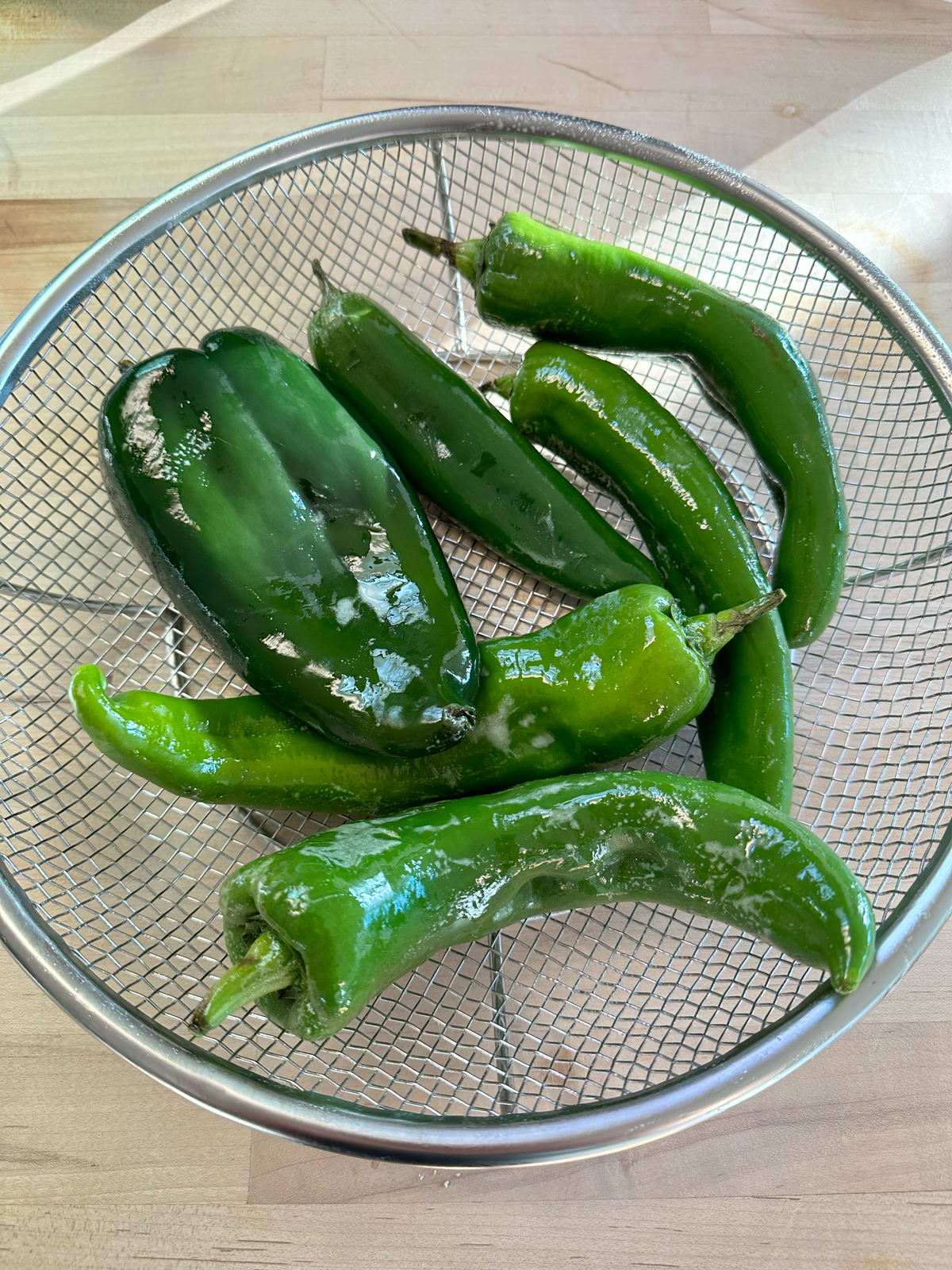
The way I did it:
I have a little grill basket I just bought and I wanted to use it. Figured a little open flame couldn’t hurt. Of course, I didn’t want to lose any of that sweet tomatillo juice down the grill grates so I put the chiles in the basket and charred them outside and popped the tomatillos and garlic in a casserole dish in the oven.
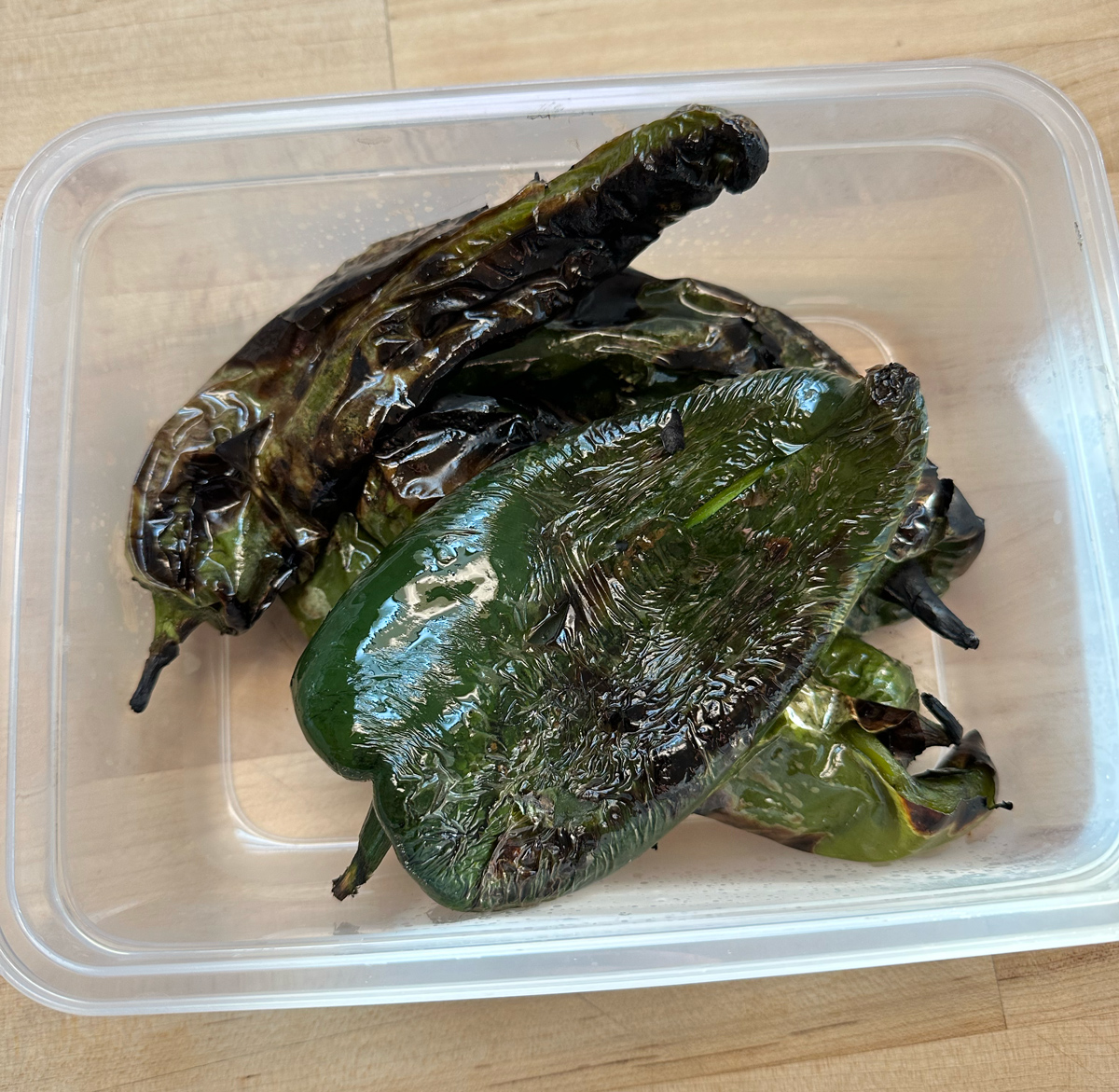
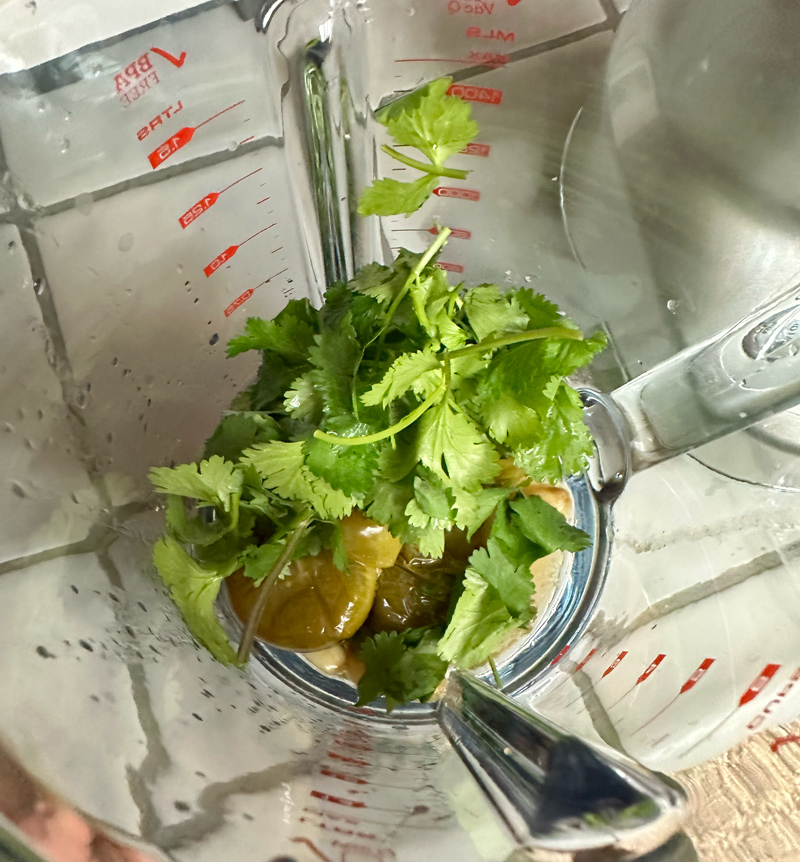
The Meat
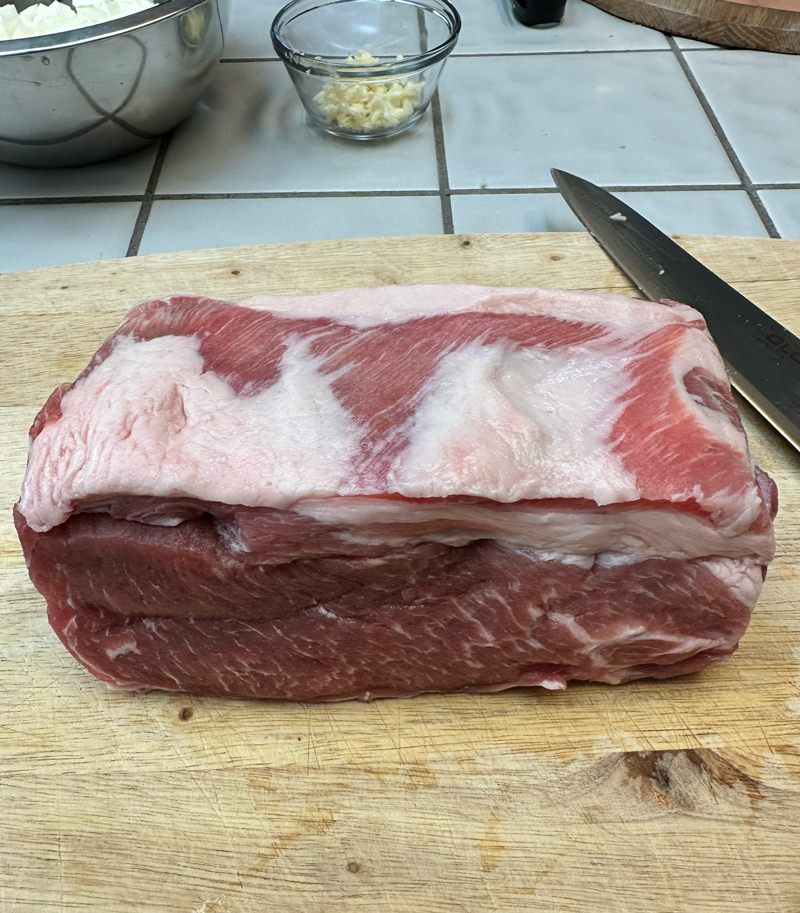
You can use a cheaper cut of pork for this, like country-style pork ribs maybe, or pre-cut “stew meat,” but in my experience, there’s a huge drop off in quality and the meat isn’t that much cheaper or easier.
- 3-6 pound pork butt/shoulder, trimmed and cut into small cubes (bigger than playing dice, but smaller than ice cubes?)
- Salt and pepper and/or your favorite seasoning blend
First, get your pot heating on the stove at medium-low. Then start trimming your meat. This one was pretty well trimmed to begin with but most won’t be, and even this had some chunks of pure fat that aren’t going to add much to the stew. As you cut those little pieces of fat off, toss them in the pot.
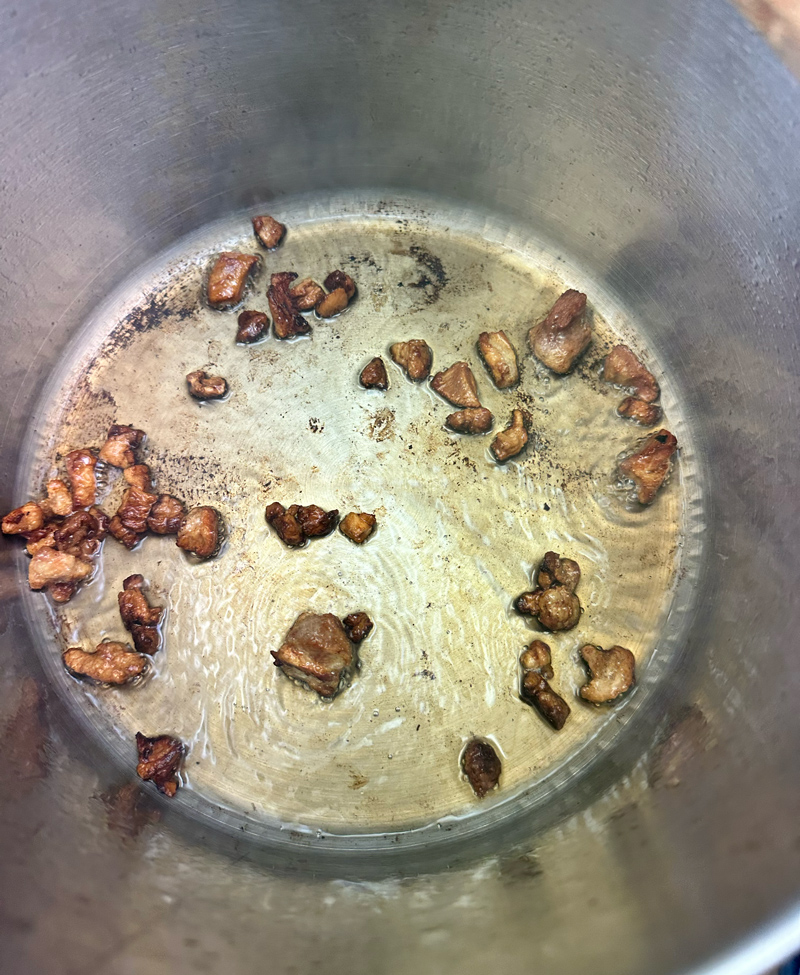
Those little fat chunks are going to render down while you butcher the rest of the meat. When they’re done you can just remove them to a paper towel to drain.
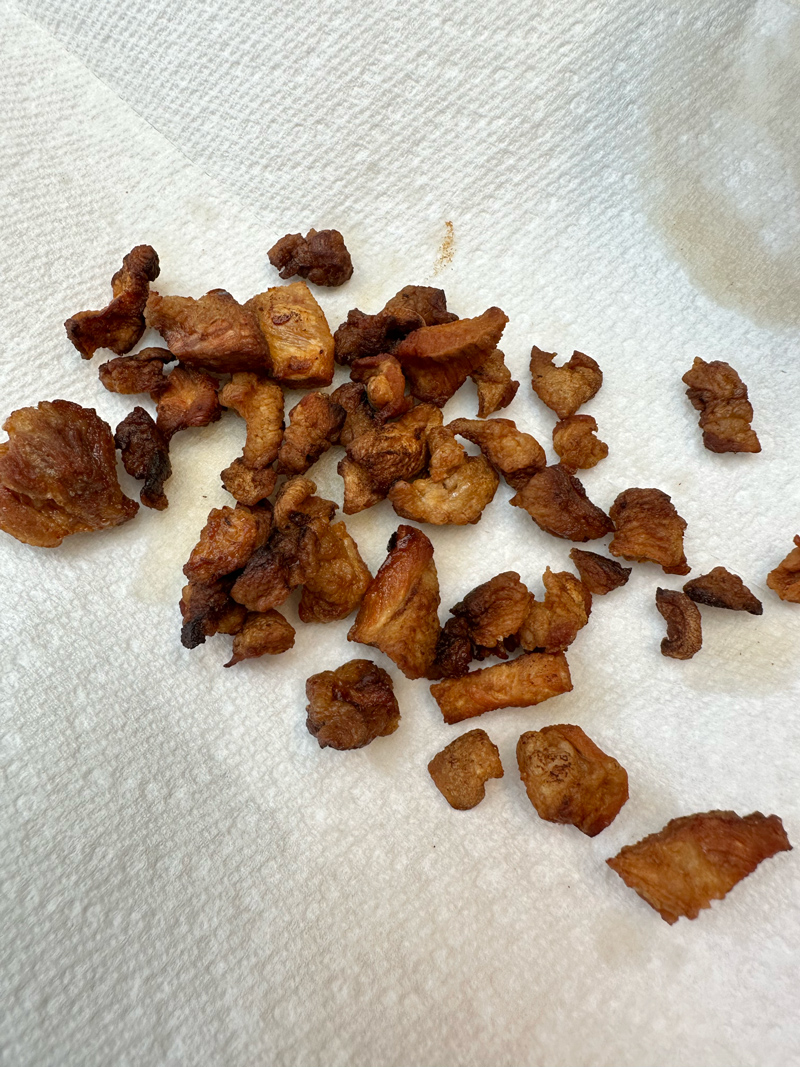
You can either save these to make a little crumble to add a little texture to the finished product, or do what I do, which is sprinkle a little salt on them and have yourself a healthy snack while you finish cooking.
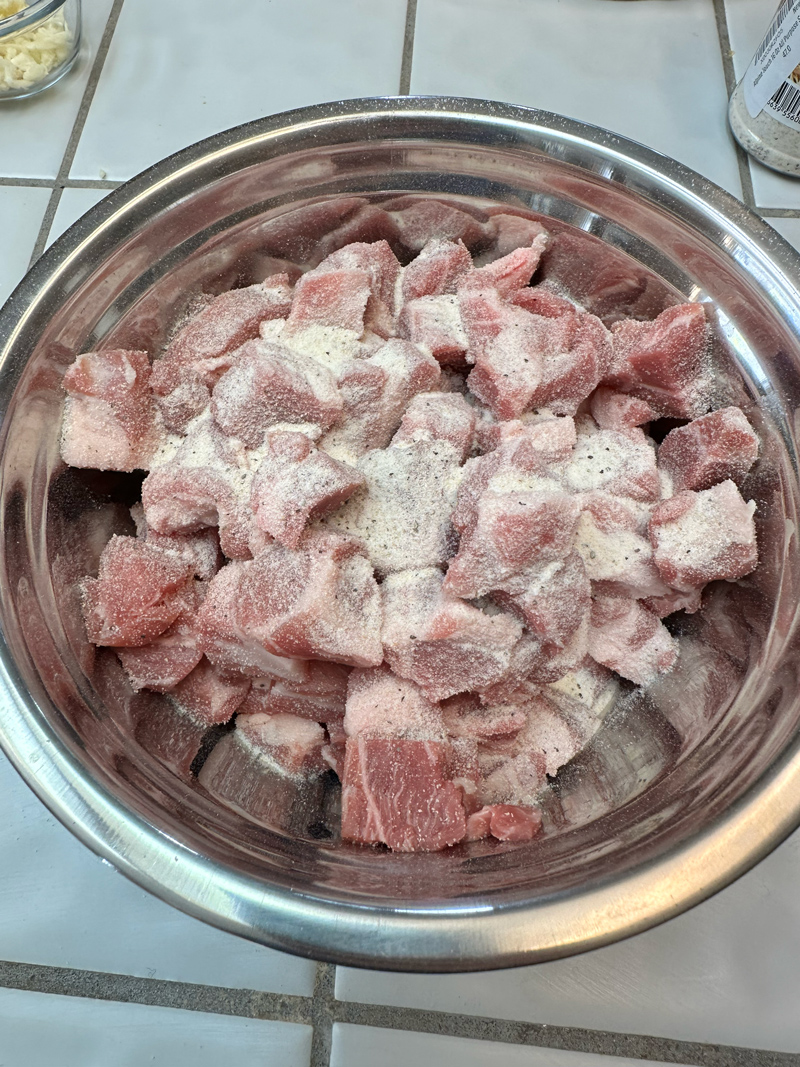
MEAT CHUNKS. I’m told that was actually my mother’s nickname in high school.
Now that you’ve got your pork cubed out and ready to rock, get it nice and coated with salt and pepper or your favorite seasoning. I used Alpine Touch all-purpose here, because I always have it around the house, it’s pretty neutral, and goes great on basically everything (I even did a prime rib with nothing but Alpine Touch, olive oil, and garlic once and it came out great). It’s just salt, pepper, onion, garlic, and MSG. If you’ve got that or a simple similar spice blend, use that. Some people use cumin. I don’t think it’s necessary or adds anything but it won’t ruin it either.
As with basically all meat, the longer you can let it sit there with the seasoning soaking into the meat, the better. But you’re going to braise all that in a seasoned broth in a minute so it’s not a huge deal if you don’t leave it sitting for very long here.
Let’s Make A Stew, Baby (A Stew Baby?)

Time to put it all together. You’ll need:
- 1 large onion, diced.
- 4-5 cloves of garlic, smashed and chopped
- The charred chile/tomatillo puree you made
- About 2 cups of the broth you made (or bought)
- The pork you cubed and seasoned
- About 1.5 tablespoons of flour (to thicken)
- Pinch of oregano
Hopefully, now you should have a pot of rendered fat (with chunks strained out). Crank the stove up to medium-high and start browning your meat in batches. You’ll want to grab a couple of handfuls of meat at a time (don’t overcrowd the pot or it won’t brown right) and get them into that hot oil. You just want to add some char and get the extra fat browned. When the meat has a little color on the outside, remove it to a plate or a bowl with a slotted spoon and get the next batch in there.
When you’re done browning the meat, turn the heat down to medium-low. At this point, if you have more than three or so tablespoons of fat in the pot, you’ll want to pour some of that off (save it or toss it, doesn’t matter for our purposes). If there’s stuff stuck to the bottom of the pan, don’t worry; that’s actually good. That’s just flavortown in there.
Get your garlic in the pot first, and cook it until it just starts turning golden (don’t burn it! dark brown is burnt!), maybe two minutes. Then drop in your onions. Cook those until they’re fully translucent and softened.
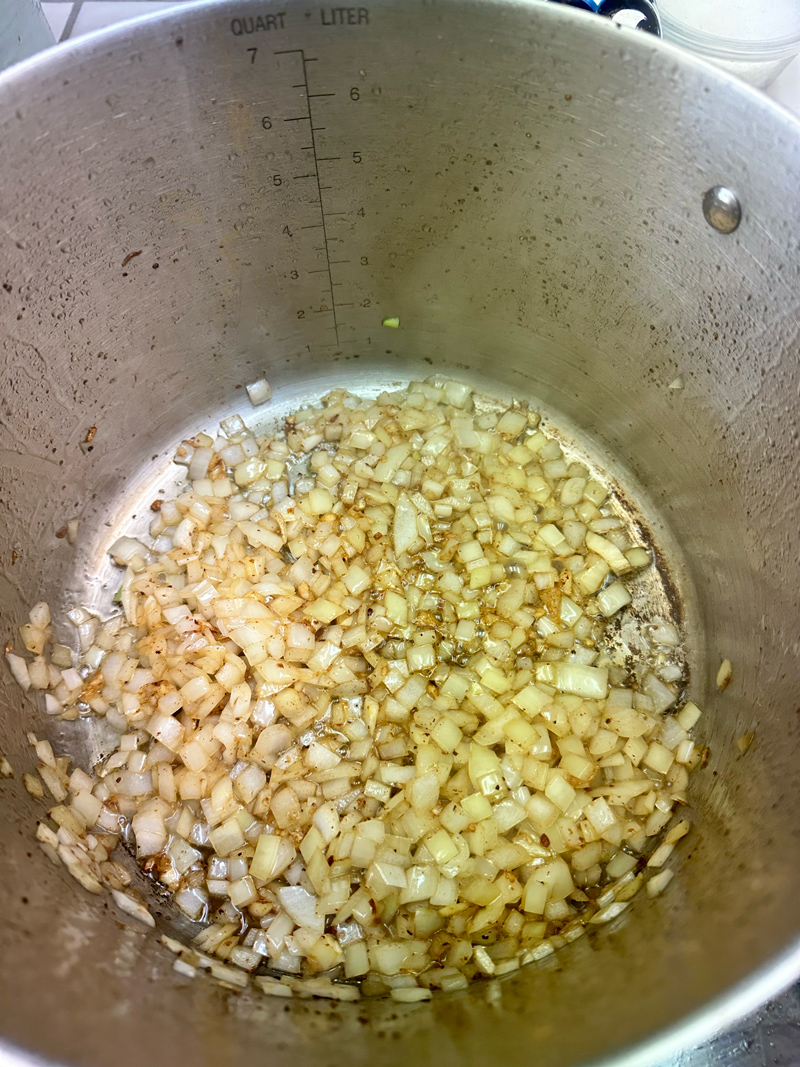
When they’re done, toss a little bit of oregano in there and your 1.5 tablespoons of flour in there and stir it up. The flour should soak up the oil and turn into a sort of paste.
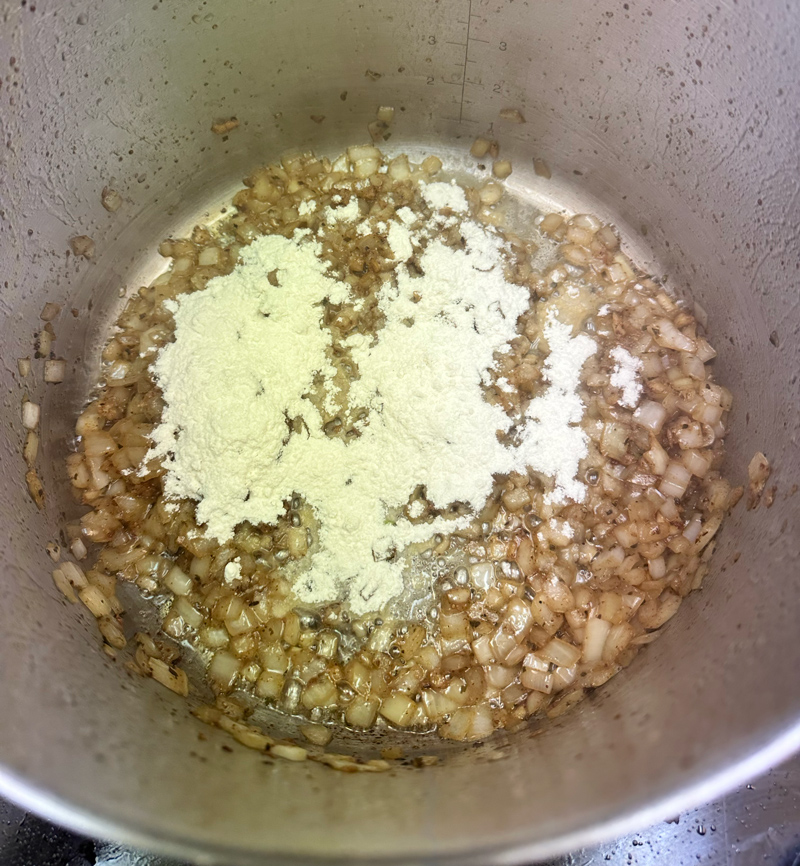
If you’ve ever seen or heard someone talk about making a roux, that’s basically what we’re doing here. Only here it’s not a huge flavor element, just a thickener, so you don’t have to keep stirring it for a long time or let it turn dark brown and all that. Just get it nice and mixed in there and cook it for a minute or so.
Now add your browned meat and enough stock to just barely cover it all. Stir it up, and all that browned flavortown on the bottom of the pot should come off and add to the broth.
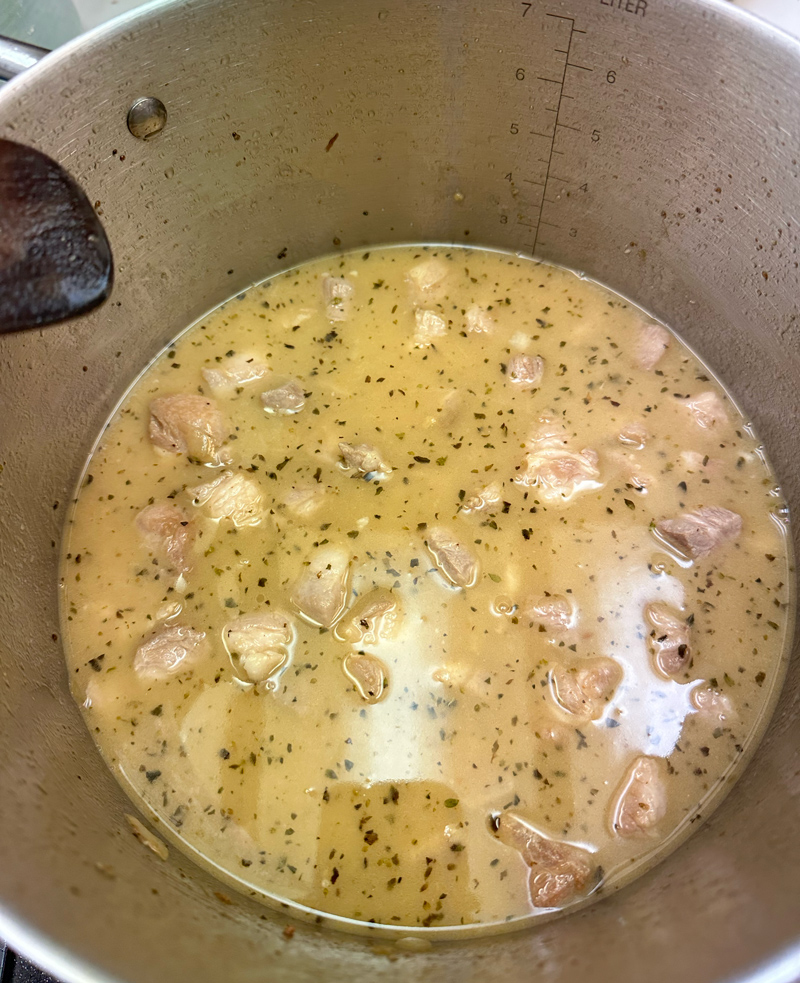
Get that up to a boil and bring it back to a simmer, and simmer it for about an hour. Now, could you just add the vegetable base puree and the stock all at once at the beginning and simmer it all for two hours? Probably! I don’t actually know if it makes a difference, but I’ve always done an hour without the green base and an hour with (two hours of simmering in total) and it always comes out great so I just keep doing that.
So, after an hour, add your chile/tomatillo puree and simmer for another hour.
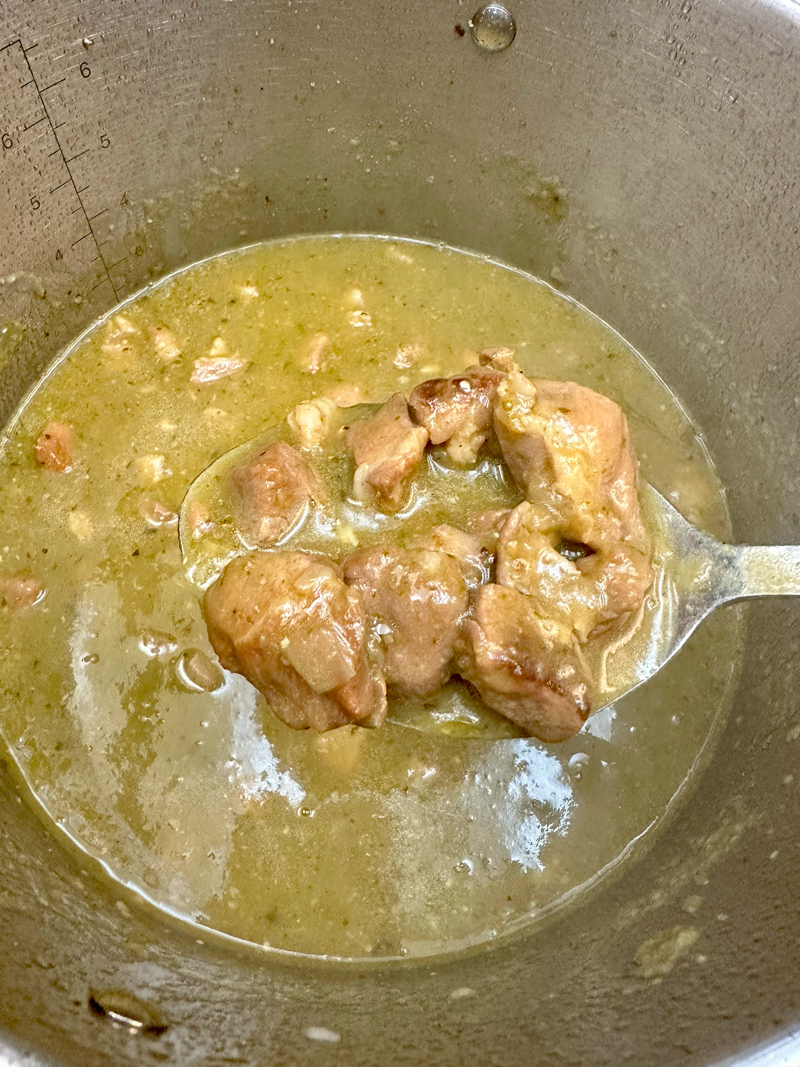
Simmer until the meat is tender enough to almost fall apart, but not so long that it gets dry (about two hours, in my experience).
Skim as much fat off the top of the pot as you can, and you’re done! (With making the stew, anyway). Again, if you’re doing this ahead of time, you can refrigerate and just pick some of that congealed fat off the top after it cools if you want. Not strictly necessary.
Serving Suggestions
I’ve had chile verde many ways over the years — in a dry burrito, in a wet burrito, as a kind of stew/soup that you dunk your tortillas into, in an upturned bowler hat (just checking to see if you were paying attention) — but over the years I’ve discovered that my ideal chile verde vessel is actually a quesadilla. A nice flour tortilla soaks up that broth like biscuits and gravy the cheese is a nice addition without interfering with the flavor, and it’s also easy to eat with a knife and fork and you can make a bunch of them at one time for a party.
If you want to be “extra” you can make your own tortillas like I did for my last party, but generally speaking the store-bought ones work just fine. I use the pre-shredded Mexican cheese blend in a bag and cook them six at a time under the broiler in my oven.
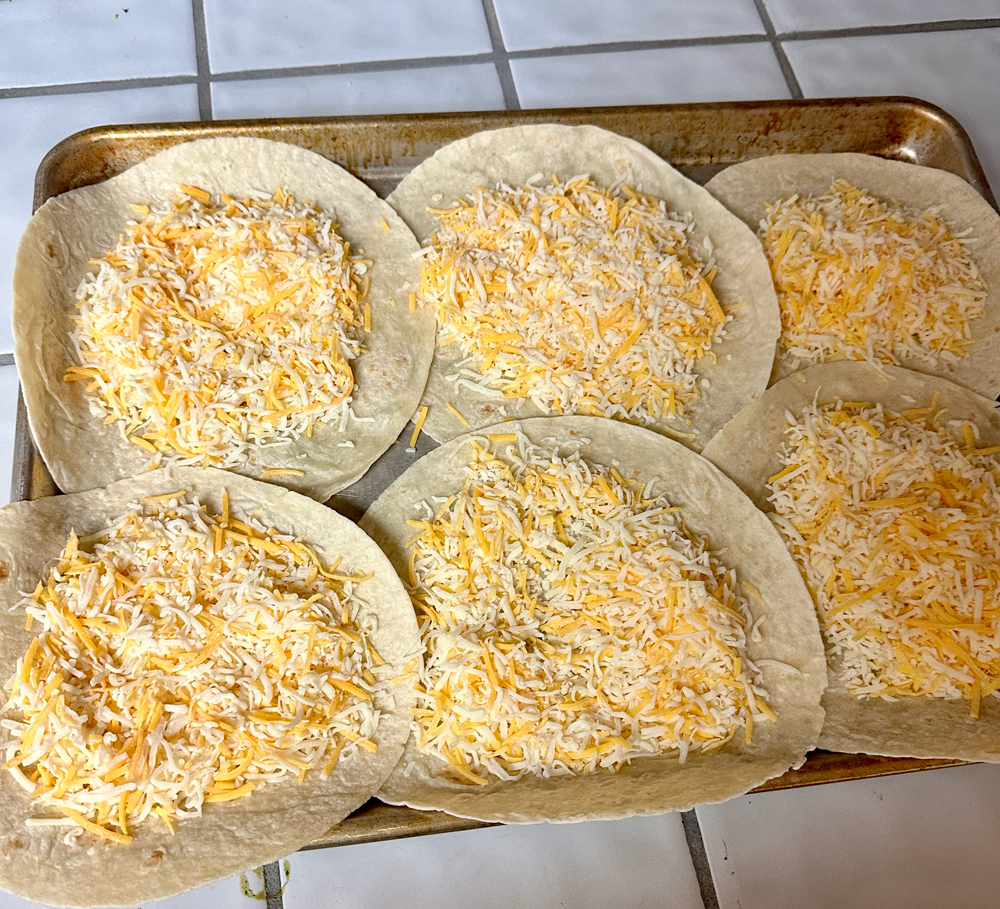
I recommend not being an idiot like me, and buying tortillas smaller than soft taco size so they actually fit on your sheet pan, but this works okay too. You can melt that cheese under the broiler than put them all in basket with a towel or whatever will keep them warm.
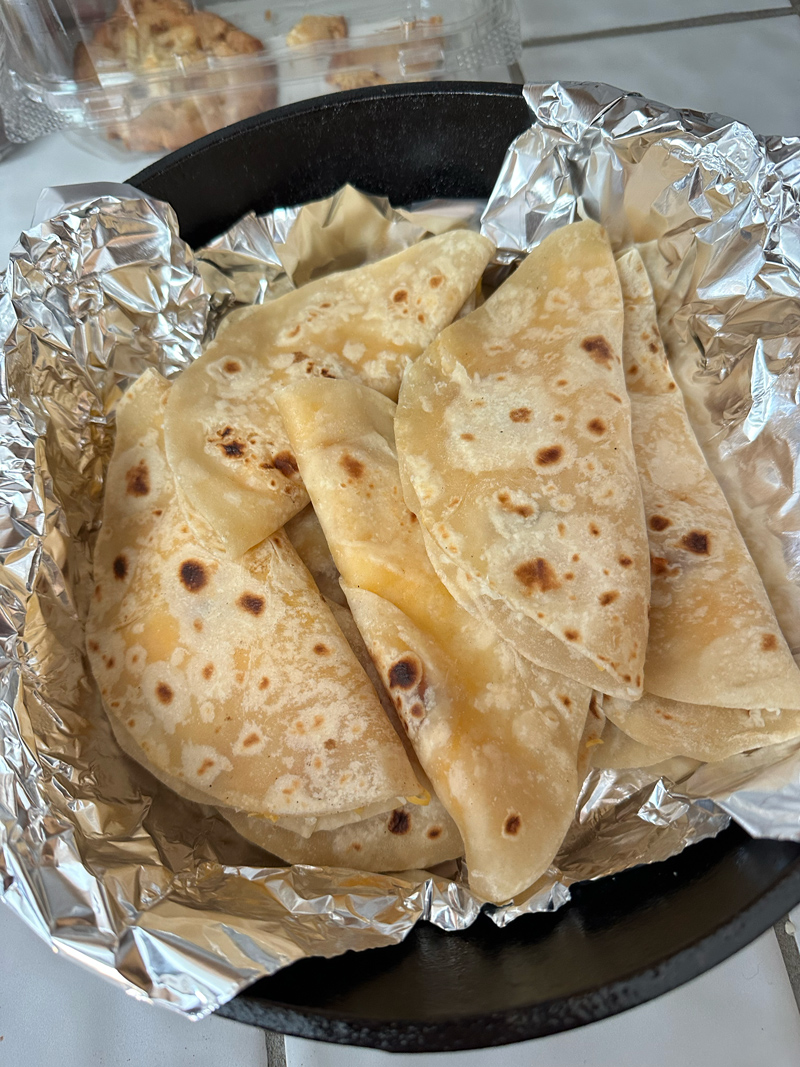
Between this and the pot, now you’ve got yourself a self-serve chile verde quesadilla bar. If your friends don’t appreciate that, find some new friends.
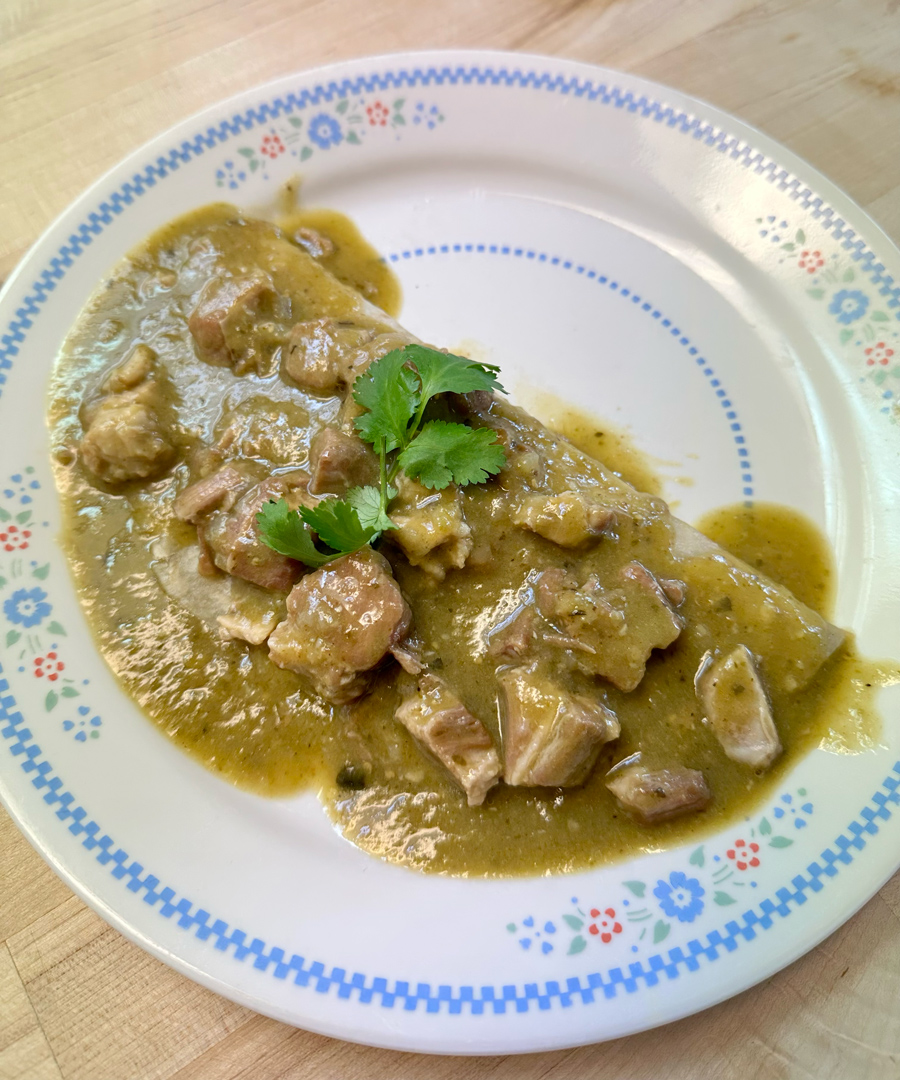
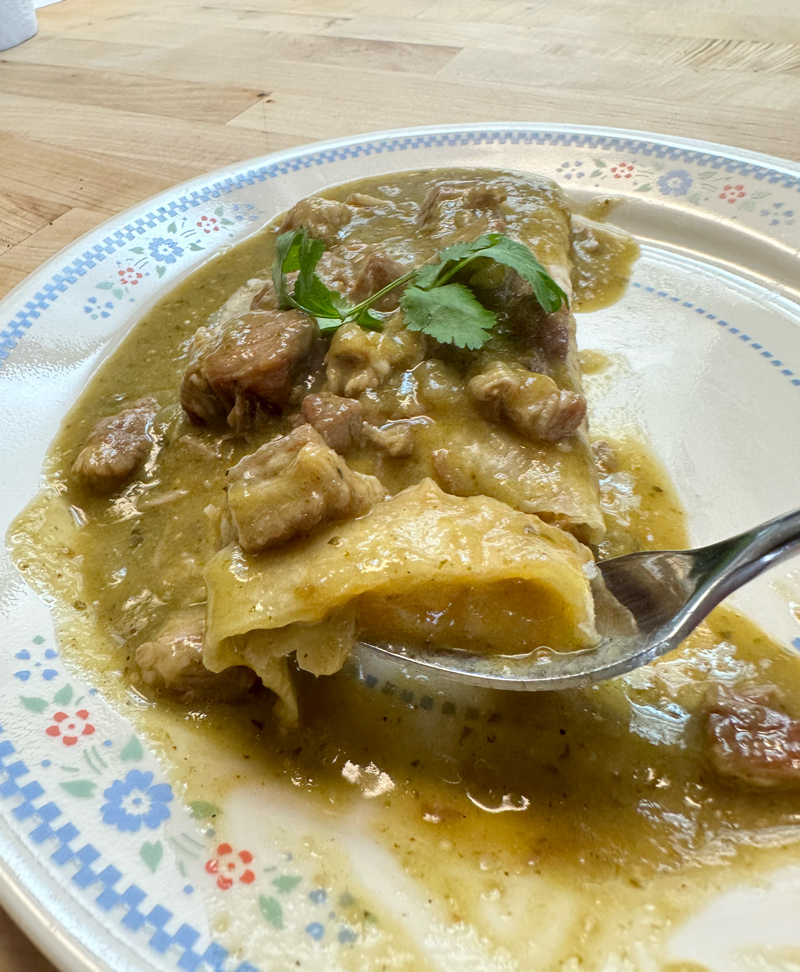
I admit it, I’m not the most beautiful plater. And I added that sprig of cilantro specifically for Steve Bramucci, Uproxx’s chief Unnecessary Herb Garnish Appreciator. But the flavors are perfect and seriously, is there anything more body-warming than a nice stew?
This one really has everything, from beautifully tender, moist, and flavorful meat, to a rich, slightly tart, and tangy sauce that actually doesn’t feel that heavy, especially compared to your usual red and brown stews. Some people even put potatoes in it, which makes sense insofar as you’re going to want to sop up this sauce with anything you can. I don’t use them but I’m not against it.
Anyway, this recipe has always been a crowd-pleaser for me, even though I love it so much that I’d probably still make it even if “the crowd” hated it. I hope it can be the same for you.
—
Vince Mancini is on Twitter. You can read more of his recipes here.







